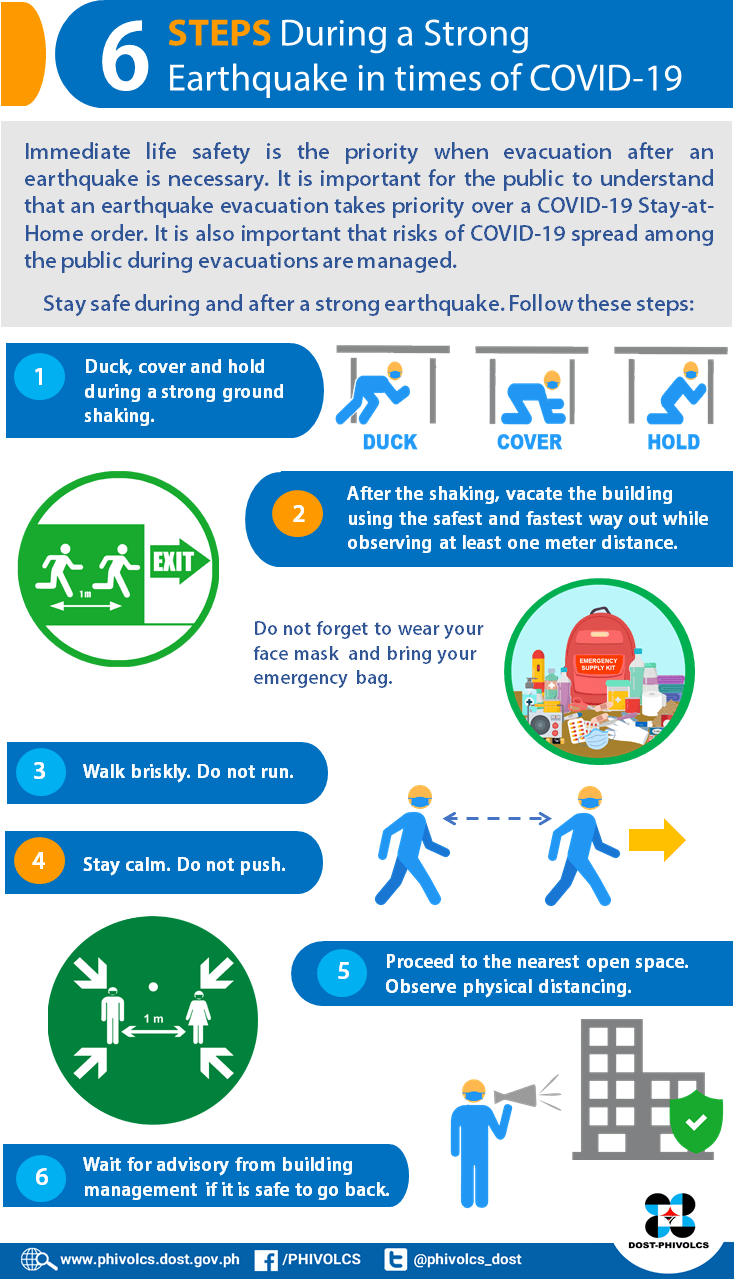
A magnitude 5.4 earthquake was recorded by the Philippine Institute of Volcanology and Seismology (PHIVOLCS-DOST) to have struck early Saturday morning in Occidental Mindoro and was felt in varying intensities in the nearby provinces of Batangas and Cavite, parts of Metro Manila, and as far as Bulacan, Pampanga, and Quezon.
The earthquake that struck at 4:06 a.m. on October 17, 2020, occurred 21 kilometers northeast of Looc town brought out the need to be aware of disaster safety protocols on top of the health safety precautions amid the ongoing COVID-19 pandemic.
How differently should people prepare and behave when earthquakes strike in areas under community quarantine?
PHIVOLCS-DOST in September released guidelines on disaster preparedness amid the pandemic, putting together an Infographic on “6 Steps During a Strong Earthquake In Times of COVID”. We share these tips to strengthen people’s awareness that if the situation requires evacuation, then it should be prioritized over the stay-at-home order of the community quarantine while maintaining health safety precautions:
- During a strong ground shaking, exercise the basic “Drop, Cover, and Hold” until the shaking stops
- After the shaking, vacate the building while wearing a face mask and carrying your emergency bag; Use the safest and fastest way out while observing one-meter physical distancing in group evacuation. An emergency or Go Bag should contain personal protective equipment such as face masks and sanitation solutions and survival items such as easy-to-prepare and non-perishable food
- Walk briskly. Do not run.
- Stay calm. Do not push others.
- Proceed to the nearest open space while observing physical distancing. Grouping during evacuation preferably by family.
- Wait for local authorities or building management advice before returning indoors
PHIVOLCS-DOST reminds the public that there is no reliable technology to predict the exact occurrence of earthquakes and thus the need to always be prepared.
“What we do is prepare earthquake scenarios of hazards and impacts to be used as a guide for mitigation, preparedness, and response,” explained PHIVOLCS-DOST.
For more information, visit: www.phivolcs.dost.gov.ph or go to HazardHunterPH for multi-hazard assessment.
HazardHunterPH allows Filipinos to access if their location is at risk for volcanic eruptions, tsunamis, and other hazards.
The Philippines’ earthquake-prone areas and natural hazards are also mapped in the new Phivolcs web tool GeoMapperPH.
TELL US in the comments below, how are you preparing for earthquakes and disasters during the pandemic?
Want to know how to be a Proud Pinoy? Like, Follow, Subscribe to GoodNewsPilipinas.com, and our socials on Facebook, Twitter, Instagram, Good News Pilipinas! TV on YouTube, for new story notifications, and e-mail newsletters for updates on more Filipino Pride stories.











